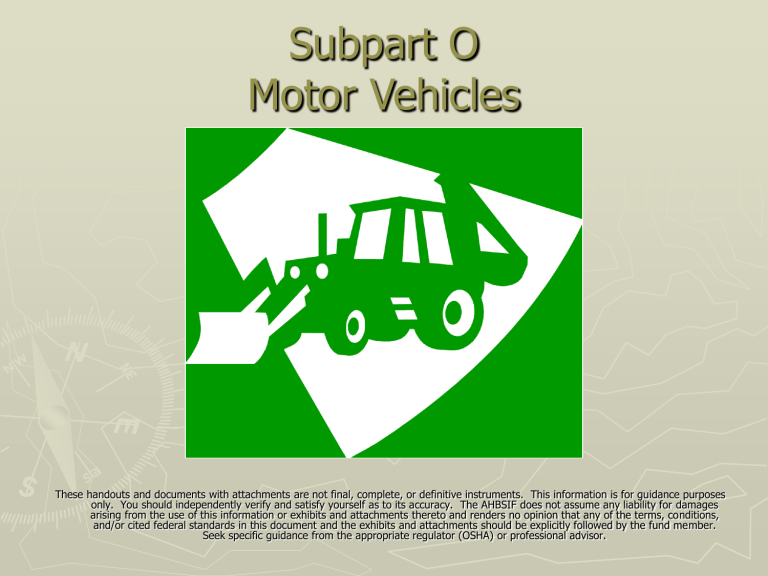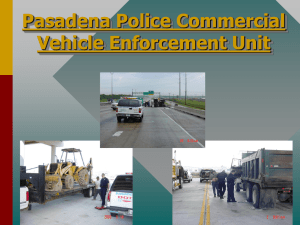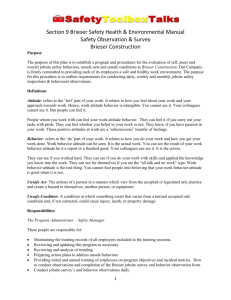Subpart O Motor Vehicles

Subpart O
Motor Vehicles
These handouts and documents with attachments are not final, complete, or definitive instruments. This information is for guidance purposes only. You should independently verify and satisfy yourself as to its accuracy. The AHBSIF does not assume any liability for damages arising from the use of this information or exhibits and attachments thereto and renders no opinion that any of the terms, conditions, and/or cited federal standards in this document and the exhibits and attachments should be explicitly followed by the fund member.
Seek specific guidance from the appropriate regulator (OSHA) or professional advisor.
Training Requirements
►
OSHA does not have specific training requirements for employees using motor vehicles and mechanized equipment on the job.
►
They do however have a general training requirement:
“Each employer shall instruct each employee in the recognition and avoidance of unsafe conditions and the regulations applicable to his work environment to control or eliminate any hazards or other exposure to illness or injury”
General Requirements
►
An employer must insure that the equipment is inspected regularly.
►
Any damaged or improperly functioning parts must be repaired immediately.
►
Operators must be familiar with the operator’s manual supplied by the manufacturer.
►
Operators must conduct a pre-shift inspection before each use.
Pre-Shift Inspection
Brake System
Pedestrian Warning
Devices
Tires or Tracks
Operator Controls
Cab Conditions
Operator Safety Systems
Couplings
Hydraulics
Fluid Levels, Battery
Connections
Grease Fittings
Boom Assembly
Body Work
Warning Decals
R.O.P.S.
(ROPS) Rollover Protection System
►
►
►
►
Intent of the system is to minimize the possibility of complete overturn
ROPS are required for all rubber tired and crawlertype off road equipment
The seatbelt is an integral part of the ROPS
Employees should never attempt to jump from a
ROPS equipped machine during rollover
Standard Specifics
►
►
►
►
All bidirectional machines must have a back-up alarm (ditch-witch and Georgia buggies are the exception)
A machine’s horn must be distinguishable from the surrounding noise level
Riding along is prohibited unless a seat and seatbelt have been provided for the extra occupant/s
No changes can be made to a machine without the manufacturer’s consent
Equipment Maintenance
►
►
Heavy Equipment parts must be suspended by slings, hoists, or jacks during repair
Make sure these procedures are followed prior to repair:
Hydraulics blocked or cribbed
Engine stopped
Controls in neutral
Brakes set
Wheels chocked
Jobsite Considerations
►
►
►
►
Soil Conditions
Be aware of weather conditions that can impact the work surface
(rain, drought, etc.)
Previously excavated soil
Areas destabilized by high traffic
Terrain
Steep grades
Uncleared lots and excessive undergrowth can hide dangerous terrain
Traffic
In addition to jobsite traffic, also be aware of auto and pedestrian traffic
Never block loading or transition areas
Emergency Routes
Never block important access paths on the jobsite
Spill Containment
►
If materials such as fuel or lubricants are discharged into soil or water, they must be contained and cleaned up properly
►
Spill napkins and absorption pads should be readily available
►
Any spill on land in excess of 25 gallons is reportable
►
Any release of petroleum into water is reportable
Spill Containment
►
Emergency Management Association (State)
334-263-7594
►
National Response Center
800-424-8802
►
No quantity is too small for clean-up
►
Soil must be excavated completely and transferred to suitable containers for transport
Jobsite Motor Vehicles
►
►
►
Back hoe
If equipped with outriggers, they must be set and vehicle properly leveled prior to digging.
For travel, back hoe must be in the upright position and bucket should be carried low.
Never operate the controls from outside the cab.
Jobsite Motor Vehicles
►
Tracked Excavator
(Track hoe)
Counterweight swing radius must be guarded against contact with machine or pedestrian
►
Soil conditions must be monitored continuously to insure stability
Jobsite Motor Vehicles
Skid-Steer
►
Most common machine on residential construction sites
►
A wide range of attachments are available
Jobsite Motor Vehicles
►
►
►
Dozer
Primarily used for clearing and grading duties
Also handle rough ditching and spreading
Soil stability and knowledge of terrain are important for safe operation
Jobsite Motor Vehicles
►
►
►
►
Front Loader
Most common in aggregate facilities and batch plants
Vehicles feature center articulation
Loads must be carried as low as possible to insure stability
Front Loaders should not be used to perform the functions of dozers, graders, etc.
Jobsite Motor Vehicles
►
►
►
►
All-Terrain Forklift
Brands include Lull, JCB, and Grad-All
Boom presents serious blind-spot, mirrors and raised boom are critical to safe travel
Some models are equipped with chassis and carriage levelers
Load capacity charts must be posted and legible in the cab









